“Merlin, if you don’t stop whining, I’m going to take Gwen’s sword and beat you to death with it,” said Arthur, evenly.
“It’s plastic.”
“So it will take me a long time. I’m still game.”
― FayJay, The Student Prince
The Orth House at 2320 Colfax Avenue South, which the Minneapolis Heritage Preservation Commission declared an “historic resource” last March, is again facing possible demolition. Owner Michael Crow has submitted an application to the HPC for a permit to wreck an historic resource.
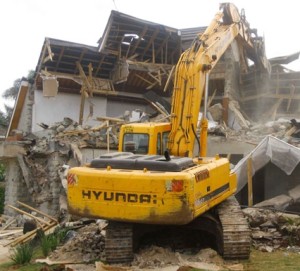 |
| The Orth House later this year? |
Here’s a summary of the events following up to this renewed attempt to demo the house:
Designed and built by T.P. Healy in 1893, the 6,400 square-foot house is currently a 15-unit rooming house. In the fall of 2012, the Lander Group put forth a proposal to wreck 2320 Colfax and the house next door to clear the site for a 44-unit apartment building. Last February when the owner applied for a wrecking permit for 2320, the Healy Project appealed to the Heritage Preservation Commission. After the HPC declared the house to be an historic resource, Crow appealed to the City Zoning and Planning Commission. The dispute came to a head at the April meeting of Z&P, which denied the owner’s request to overturn the HPC’s ruling.
In this second round in the owner’s effort to get a demolition permit, the process is essentially the same as last year. The HPC will hear Crow’s application at its February 18th meeting. If the HPC allows the permit, demolition can go ahead to clear the site for the Lander Group’s four-story apartment building, unless the Healy Project appeals, which it will. If the HPC denies the permit, Crow can appeal to the City’s Zoning and Planning Commission to overturn the HPC’s decision.
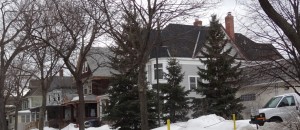 |
| The 2300 block of Colfax Avenue South, Orth House at far left. If 2320 is wrecked, the houses on the entire 2200-2300 block will be in danger, including two other houses by T.P. Healy and two more by Harry Jones. |
The house has been declared an historic resource, so arguments for demolition will be focused around the economics of development. The cleared land is worth about a third more than the land with the house on it. The owner claims it is his right to sell it for top dollar. No matter that he has had income out of the house for the two decades he owned it, with no improvements to the property except repairs and maintenance. The City in fact would be rewarding a landlord who made only required repairs to his property, while penalizing neighboring homeowners who have invested considerable sums into renovating and restoring their houses. Why are their houses worth more than 2320? Their investment. Why is 2320 worth less than the land it stands on? Crow’s choice to minimally maintain the house as income property.
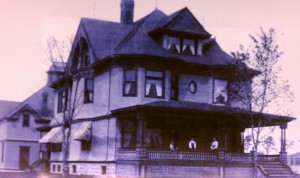 |
| The Orth family on the porch of their house (2320 Colfax S.), 1890s. |
Zoning and planning issues (which this is) are hot-button ones. This fight between a developer and the neighborhood will go on at City Hall until the bitter end. Residents in the surrounding neighborhood are banding together to stop Crow and the Lander Group. The Healy Project will continue to fight against the Lander Group’s ill-conceived, wasteful development and advocate for a development plan that incorporates the Orth House.
For more background on the fight to save the Orth House see posts on this blog from January to June 2013.
Meanwhile, across the city. . .
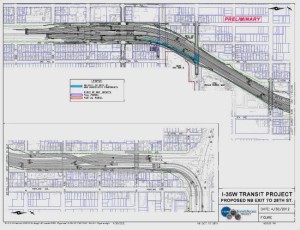 |
| Bulge in the boa: Plan of proposed 35W expansion at Lake Street. |
Homeowners in the Healy Block Historic District are fighting to stop the widening of 35W at the 31st Street exit ramp. Nearly three years ago, plans were initiated for the $150 million Transit Access Project (TAP), which calls for a $46 million bus station in the middle of the freeway at Lake Street. The new station will offer easier bus connections to Lake Street and access for bicyclists to the Midtown Greenway. However, along with the station, plans call for expanding the northbound off-ramp by thirty feet, bringing the pavement virtually to the front yards of the famous Healy Queen Anne houses on Second Avenue.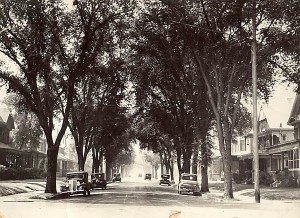
|
| 1936 photo of Second Ave S. from the 31st Steet intersection |
David Piehl, who lives in the J.B. Hudson House on Second Avenue, has been working with the various government agencies involved to convince them that expanding the highway would render the houses unlivable. In the 1960s construction of 35W took the west side of the block, and since then, traffic has rumbled by the houses 24/7. Piehl points out that living on the block already is stressful. The houses shake, plaster cracks, windows rattle, bathwater ripples. The air on the block is among the most polluted in the state. Bringing the highway even closer would create intolerable emotional stress for the residents and structural stress to the buildings.
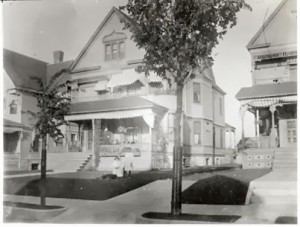 |
| The Hudson House in the days before people sitting on the porch didn’t see a freeway across the street. |
Piehl and other residents of the Healy Block have formed a group called Stop35W to inform the public about this renewed threat to their homes. They have posted signs in their front yards and set up a website (http://stop35w.org/main.php). In November, the Healy Project’s kickoff tour showcased this block to show what kind of woes freeway expansion would amplify on this already-besieged historic area. (See Oct. 31, 2013 post)
Links to articles about the 35Wexpansion:
Commentary about TAP:
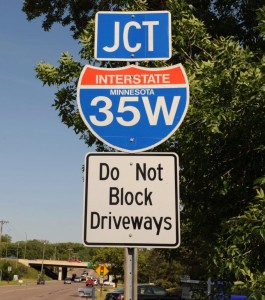 |
| Do not pave up to historic houses. |
Watch this blog and the Healy Facebook page for news about these ongoing battles to preserve the investments of Minneapolis owner-occupants and the architectural legacy of Minneapolis.
In 1980 when then-Wedge-resident Anders Christensen examined the building permits for all the houses in Lowry Hill East, he discovered that a master builder named Theron Potter Healy had built 30 of them. Further research revealed that during his career (1886-1906), Healy had built over 120 houses and commercial buildings in Minneapolis.
In 1993 Healy’s most celebrated creations, the Queen Annes of the 3100 block of Second and Third Avenue South, received national historic designation as the Healy Block Historic District. In 1977 Healy’s Bennett-McBride House had been listed on the National Register of Historic Places as a superb example of the Queen Anne architectural style.
During the first Wedge Zoning and Planning Committee meeting on the Lander Group’s redevelopment plans for 24th and Colfax, architect Pete Keeley said he had contacted the City, and they had said the two houses slated for demolition had “no historical significance.” At the second meeting, another man supporting owner Michael Crow alleged that the Minnesota Historical Society, too, had said that the Healy house at 2320 was not historically important. I’m sure that both claims are true: Neither the City nor M.H.S. have anything on record about either house.
None of Healy’s Wedge houses have received historic designation, but that does not mean that they are not historic or architecturally significant. Many historic buildings have not received official historic designation (through the Historic Preservation Commission or the National Trust, for example), but that in itself does not speak to their importance.
Consider, for example, the Wedge’s own “Healy Block”, the 2400 block of Bryant Avenue South. Eight (probably nine) houses on this block are Healy’s: 2401, -05, -09,(-10),-20, -24, -28, -36, and -39, ranging in style from Queen Anne to Colonial Revival.
 |
| 2439 Bryant, Colonial Revival, 1905 |
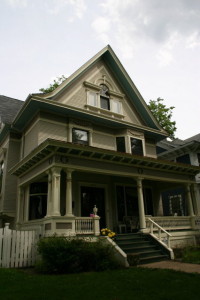 |
| 2409 Bryant, Queen Anne, 1895 |
|
|
|
|
|
|
|
|
|
|
|
|
|
On Bryant Avenue north of 24th Street (in the R-6 zone) are four other Healy houses; three of these are currently rooming houses. None of the houses on the 2400 block are rooming houses, although half of them were at one time. Former residents have told stories of tenants riding motorcycles up staircases, drunken brawls, drug deals, even murders taking place in these houses. Yet today, with the investments in time and money of their owner-occupants, they have become beautiful and valuable homes.
2320 Colfax, the Healy house slated for demolition, represents a pivotal point in Healy’s career. It is one of only two houses built by Healy in 1893. The other 1893 Healy house, 821 Douglas Avenue, was wrecked in 1981 by developer Paul Klodt. 1893 is a significant year in the history of architecture, the year of the Chicago World’s Fair. In this year the Queen Anne style began to fall out of fashion, replaced by the Colonial Revival style, made popular by the Fair’s “White City”. 2320 is Healy’s first Colonial Revival house, a significant part of his architectural legacy.
An old photo of 2320 reveals the original appearance of the house, with a large barn in back, and open field to the north:
 |
| The Orth House, 2320 Colfax, as it appeared when new. |
 |
| The house today. The porch has been enclosed, but the original roof line, profile, and fenestration remain. |
Obviously, some people don’t care diddlysquat about history or architecture, and this blog is not addressed to them. I have learned a very important lesson from my service on the Minneapolis Heritage Preservation Commission and the Advocacy Committee of the Preservation Alliance of Minnesota: Governments and institutions are not concerned with saving buildings. Communities must define and speak out on what’s important to the community–and work to preserve it.
The 2004 LHENA Zoning Task Force clearly articulated what is important to Wedge residents, that is, ensuring the livability of the neighborhood by preserving the current mix of houses and multiple-unit buildings. Michael Lander has already redeveloped the southern part of the Wedge along the Greenway with high density apartment buildings and condominiums. This redevelopment makes sense in that it replaced a defunct industrial area. But the apex of the Wedge is a different story. Development supporters have made much of the idea of saving the neighborhood “core”, while keeping the “fringe” high density. Truth to say, the apex is such a small area that most of it can be considered “fringe” of the greater neighborhood, the current view from City Hall. The point is moot: R-6 allows high density throughout, so-called “core” included.
Last month a first in a series of meetings was convened by the City to look into the feasibility of establishing “conservation districts” in Minneapolis. Such districts would offer more protections than the zoning code, but fewer than those of historic districts, such as the Healy Block. A conservation district would certainly be a big step forward in saving the houses in the apex of the Wedge, but the idea is only at the beginning of a long planning process, with no guarantee it will be adopted.
 |
| “360 Degrees of Wedge Healys”–Photo art by Richard Mueller |
In conclusion, I want to stress that if you want to save 2320 Colfax and preserve the other houses in the Wedge, don’t expect City Hall or an historical society to do it for you. Property rights are held sacrosanct in this country, and owners can wreck properties on the National Register if they so choose. Case in point–the developer in Arizona who wants to demolish a house designed by Frank Lloyd Wright. Despite a firestorm of outrage and temporary stay of demolition from the City of Phoenix, the developer is still determined to take it down.
Former Zoning Task Force member Sue Bode said at the first LHENA hearing about the 2316-2320 plan, “Taking down a Healy house is like destroying one by Frank Lloyd Wright.” If you care about Healy’s legacy, if you care about the old houses of the Wedge, speak out.
 |
| CAN PREVENT DEMOLITIONS! |
|
–T.B.
I. The Sad History of Zoning in the Wedge (Lowry Hill East)
 |
| Map of Lowry Hill East |
As followers of the Healy Facebook page know, in October, the Zoning and Planning Committee for the Lowry Hill East Neighborhood Association (LHENA) met to look at a proposal by the Lander Group to redevelop a site on the northwest corner of Colfax Avenue and 24th Street in the Wedge. The proposal, presented by Peter Keely of Collage Architects, called to wreck two extant houses, 2316 and 2320 Colfax, and erect a five-story, 48-unit apartment building. While emphasizing the “green” aspects of the proposed building, Keely also repeatedly stressed that it was considerably smaller than R-6 zoning allows.
After Keely’s presentation, the large group in attendance spoke of their concerns. Comments ranged from outrage at the size of the project to arguments in support of it from the man who owns the two houses, Michael Crow. The majority of the response was decidedly negative. At the end of the discussion, Steve Benson, chair of the 2004 LHENA Zoning Task Force. spoke eloquently of the need to secure the livability of the neighborhood by preserving the extant houses. Keely, after saying earlier that the proposal was the only “economically feasible” one for Lander, agreed to come back with another one at the November meeting.
What has all this to do with Healy? The Orth House at 2320, currently a 17-unit rooming house, was designed and built by Healy. According to Michael Crow, the original architectural features are gone, and it would be no loss to wreck it. The architect reported that City Planning agrees, saying that it has “no historical value.” Well, if the house really is as torn up as they contend, I wonder who’s responsible. Could it be Crow, who has run the place as a rooming house for the 21 years he’s owned it?
I will return to the historical and architectural importance of 2320 in another post, but now I’d like to focus on zoning issues and how they relate to preservation. I know, zoning is one of those topics that put people to sleep. But before you start dozing off, please try to keep awake long enough to learn the background of zoning in the Wedge.
In 1963 the City upzoned much of Minneapolis, including the Wedge, to high density R-6 zoning. These were the postwar days when much of old Minneapolis fell to the wrecking ball (the Metropolitan Building, for example). When the Wedge was upzoned, the houses started to come down by the scores, replaced by two-and-a-half story walkup apartment buildings. The City made the north-south streets into “paired commuter one-way corridors”, that is, racetracks for suburbanites to speed through the scary inner city.
In 1970, a group of Wedge residents banded together to form LHENA for the purpose of cleaning up and stabilizing the neighborhood. They picked up trash, they fought slumlords, they put unruly tenants on notice, they started “The Wedge” neighborhood newspaper. Their main goals, however, were to better control traffic flow and to downzone the Wedge to a lower density designation.
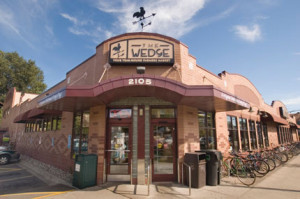 |
| Minneapolis’s first co-op market, the Wedge, was founded in 1974. |
Amazingly, LHENA partially succeeded in meeting these goals by getting rid of the north-south one-ways and by downzoning the inner core of the area south of 24th Street to R-2B. North of 24th Street, however, R-6 zoning remains in place for all of the existing houses. In 2004 LHENA’s Zoning Task Force submitted a detailed plan to the City, arguing why downzoning the Wedge apex is essential for retaining the unique character and livability of the neighborhood. The City (figuratively) threw the study into the wastebasket. Apparently the City is quite happy with R-6 in the apex and is looking forward to cramming into it as many units as possible.
On November 14th, Peter Keely returned to the LHENA Zoning and Planning Committee with a new plan for the 2316-20 redevelopment. The revised proposal, it turns out, requires no variances from the City to build. Big surprise, eh? The fact is that as long as R-6 zoning is in place, developers can build pretty much whatever they want, without the blessing of the community. Presenting this plan to the zoning committee is simply window-dressing for Lander. At the second meeting, the focus was on hearing and commenting on the proposal. Anders Christensen was allowed to speak briefly on the historical significance of the houses. A man who identified himself as a supporter of Michael Crow claimed that the Minnesota Historical Society says that 2320 has no historical importance (more on this in next post), and the committee’s attention returned to issues such as parking, the placement of garbage cans, the wonders of brownstone, etc. “Progress” marched on.
 |
| Returning soon to the Wedge? |
The most alarming aspect of this seemingly benign proposal is that it signals a return to the Bad Olde Days of house demolition, with the attendant fallout of displaced tenants. After nearly four decades of stability, the residents of Lowry Hill East–and those at City Hall–must decide if they really want to see the apex of the Wedge turned into a nondescript Midwestern version of the Bronx, indistinguishable from other redeveloped urban areas–or if they want to retain the distinctive charm of the existing blend of houses and smaller apartment buildings.
The reality is that with R-6 zoning, developments like this cannot be stopped via the mechanism of City government. But that is not to say they can’t be stopped. Lowry Hill East’s nickname “The Wedge” came about not only to reflect the shape of the neighborhood, but the direction of its political thrust.
If and when these two houses fall, others will inexorably come down, too. It would be the end of the Wedge as we know it. Preservationists, those who love the Wedge and its houses, it’s time to stand up and be counted.
–T.B.
Next: The architectural and historical importance of Healy houses in the Wedge.
















